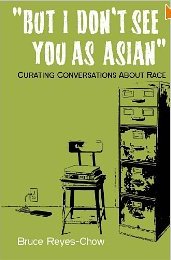Analyzing race and power: A Review of But I don’t See You as Asian: Curating Conversations on Race by Bruce Reyes-Chow – Cynthia Holder Rich
 Bruce Reyes-Chow has done a great service and contributed an important work to the conversation about race and power. Reyes-Chow’s 2013 volume But I Don’t See You as Asian got a lot of buzz, not only for its provocative title, but because he puts his finger on some key issues that call out for serious conversation.
Bruce Reyes-Chow has done a great service and contributed an important work to the conversation about race and power. Reyes-Chow’s 2013 volume But I Don’t See You as Asian got a lot of buzz, not only for its provocative title, but because he puts his finger on some key issues that call out for serious conversation.
Reyes-Chow, Presbyterian pastor and former Moderator of the General Assembly, offers readers an approachable volume that invites – even beckons – people into a dialogue they may have not previously engaged. His affable style leads him to note and remark upon racism he has experienced with honesty – but never anger. Reyes-Chow has written in shorter forms about race and racism in the past; while sometimes he has received affirmation, at other points the comments show that racist incidents are still very much a part of his life. (That is – while this is usually a bad idea, please read the comments on this last link if you believe racism is a thing of the past. Read and learn. Bruce has experienced worse, but you will begin to get the idea. Search race on his blog for more examples – or just read his well-written and thoughtful blog.)
In his new book, Reyes-Chow explores the ways that people talk about race. The reality is that the subject is rarely brought up in much of polite conversation. Reyes-Chow gently encourages conversation around an issue that is central to his experience of life. In that he pastors in an almost-exclusively white denomination, he serves with many people who have never had to think about race – and for some, when they have it has been sufficiently unpleasant (read white guilt) to encourage future wariness around the subject. Recent research trajectories exploring the racial attitudes of most white people do not encourage optimism. So encouragement is needed to have the conversation – to plan for and construct places and spaces where people feel adequately safe to talk without fear, sharing both their experiences and their impressions and be heard and respected. Reyes-Chow’s book is important for the encouragement and strategies he offers toward these ends.
 The book unpacks a number of stereotypical ideas about Asian Americans – everyone of them being good at martial arts, or the question of where people are from (embarrassing when asked of people who are from, perhaps, the same state as the questioner), or Asian-ness as “a different form of black”, and the cachet, the current “popularity”, of being Asian. He tackles tokenism (sometimes called ornamental diversity), hostility toward persons in the minority gravitating toward each other and seeking out places and times for internal community conversations, and the tricky issue of what one person (say, someone Asian-American or African-American) can say which others cannot.
The book unpacks a number of stereotypical ideas about Asian Americans – everyone of them being good at martial arts, or the question of where people are from (embarrassing when asked of people who are from, perhaps, the same state as the questioner), or Asian-ness as “a different form of black”, and the cachet, the current “popularity”, of being Asian. He tackles tokenism (sometimes called ornamental diversity), hostility toward persons in the minority gravitating toward each other and seeking out places and times for internal community conversations, and the tricky issue of what one person (say, someone Asian-American or African-American) can say which others cannot.
I left the book with some lingering questions. Reyes-Chow self-published this book after conducting a very successful KickStarter campaign – kudos to him. I’m wondering about the future of these kinds of projects and hoping that the editing goes well in the future. I also wonder how Bruce can remain so positive in the face of the continuing, robust and persistent demons of racism. Anger does not come through, which undoubtedly helps people hear his message. I wonder what role righteous anger might play in attacking these demons. Would love to have a curated conversation with Bruce on this one! Finally, I am wondering, with some hope, that this is not the last word Bruce Reyes-Chow will offer on this important topic. I leave the book grateful for this contribution and wanting more.

